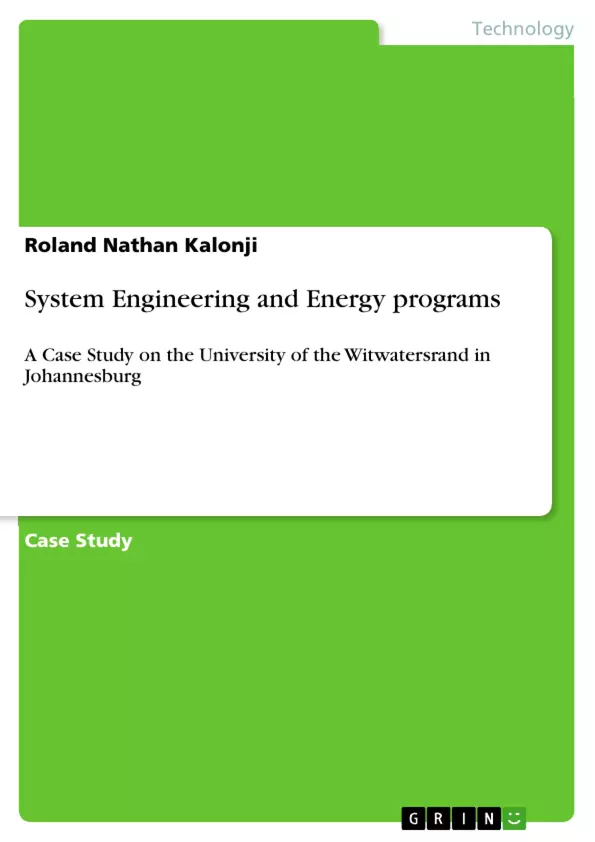First off, this project gives insight into how to define various systems management (project management and systems engineering) terms and to answer to the frequently asked questions in systems management. Specifically, to think like a systems engineer by changing the way of approaching and specifying a solution or addressing problems. Then the overall purpose is to use and apply Systems Engineering approaches to solve the high levels of unstructured problem situation and try to structure a debate concerning actions for improving the problem "energy program" situation within the System (University of Witwatersrand-Johannesburg).
Inhaltsverzeichnis (Table of Contents)
- 1. Introduction
- 1.1 Stakeholders Analysis
- 2. TASK#1: Situation Analysis via - Peter Checkland's SSM.
- 2.1 Step n°1: Problem Situation: Unstructured...
- 2.1.1 The Naive Picture
- 2.1.2 The Problem Statement..
- 2.2 Step n°2: Problem Situation: Expressed
- 2.2.1 The Rich Picture:.
- 2.2.2 The Relevant Systems.
- 2.3 Step nº3: Root definition on relevant system...........
- 2.3.1 Root definition of the Ellies Renewable energy.
- 2.3.2 The CAPETOWN MODEL
- 3. TASK#2: Outline:
- 3.1 Five functions of a Systems Engineer.
- 3.2 The purpose of the Systems Engineering Management Plan (SEMP)
- 3.3 Systems Engineering Management Plan (SEMP)
- 3.3.1 Statement of Work (SoW)..
- 3.3.2 Scope of Work
- a. Technical Objectives:
- b. Assumptions and Constraints
- 3.3.3 Ellies System Structure.....
- 3.3.4 Work Breakdown Structure (WBS).
- a. Schedule Planning......
- b.Major Deliverables.
- c.Major phases
- d.Responsibility Assignments..
- 3.3.5 Risk Management.
- 3.3.6 Operation and Maintenance
- 4. Conclusion
Zielsetzung und Themenschwerpunkte (Objectives and Key Themes)
This case study aims to explore the implementation of a comprehensive energy efficiency program at the University of Witwatersrand, Johannesburg. The study focuses on utilizing Systems Engineering approaches to address the challenges and complexities of the program, particularly in managing the high level of unstructured problem situations. It seeks to provide a structured framework for decision-making and action planning to achieve significant energy savings.
- Systems Engineering methodologies in managing complex projects
- Stakeholder analysis and engagement in energy efficiency initiatives
- Problem definition and solution development using Checkland's Soft Systems Methodology (SSM)
- Implementation of a Systems Engineering Management Plan (SEMP) for the energy program
- Risk management and operational considerations in energy efficiency projects
Zusammenfassung der Kapitel (Chapter Summaries)
- Chapter 1: Introduction This chapter provides a general overview of the case study, introducing the University of Witwatersrand's energy efficiency program and its goals. It highlights the role of Systems Engineering in addressing the complexities of the program.
- Chapter 2: TASK#1: Situation Analysis via - Peter Checkland's SSM. This chapter delves into the application of Checkland's Soft Systems Methodology (SSM) for analyzing the problem situation. It discusses the various steps involved in the SSM framework, including identifying the naive picture, formulating a problem statement, and constructing a rich picture of the relevant systems.
- Chapter 3: TASK#2: Outline: This chapter presents the development of a Systems Engineering Management Plan (SEMP) for the energy program. It outlines the five functions of a Systems Engineer and the purpose of the SEMP, covering aspects such as the Statement of Work, Scope of Work, Ellies System Structure, Work Breakdown Structure, Risk Management, and Operation and Maintenance.
Schlüsselwörter (Keywords)
The case study focuses on the application of Systems Engineering principles to address the challenges of the energy program at the University of Witwatersrand. Key terms include: Systems Engineering, Soft Systems Methodology (SSM), stakeholder analysis, problem situation, energy efficiency, SEMP, risk management, operation and maintenance.
- Arbeit zitieren
- Roland Nathan Kalonji (Autor:in), 2017, System Engineering and Energy programs, München, GRIN Verlag, https://www.grin.com/document/426006



